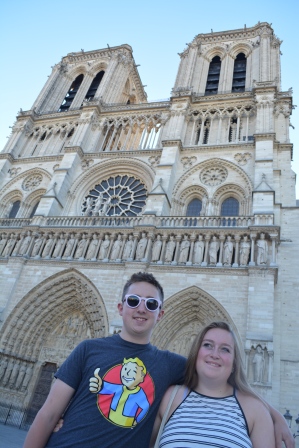The scenes from Paris were (and are) startling and heartbreaking. When part of the spire of Notre Dame fell into the huge cauldron of flames, I gasped. It was hard to take it all in from the vantage point of my laptop computer so many miles away. Clearly, I could appreciate only a very small sense of what it was like to watch the beautiful cathedral burn.
Structure fires always conjure a special dread. They are so striking, as the flames consume everything they can, while they seem to leap and dance at the same time. Church fires feel particularly heartbreaking. Last year, the large Baptist church in my hometown burned in a massive fire. Although I wasn’t there, the photos were enough to make me feel ill. Something precious and important had gone.
While terrible and heartbreaking, I must also make a confession: I wouldn’t mind a fire, a fire at Old South. It’s hard to type out those words, but they are true. I wouldn’t mind a fire. After the first shock of watching the Baptist church in my hometown burn, and then discovering that it had been hit by lightning, I wondered: why can’t we experience a bit of lightning?
Old South has a beautiful sanctuary building, graceful and elegant. The exterior is made of large, granite blocks, extracted from the earth at a local quarry. The interior is lovely with its decorative organ pipes and its acoustically inclined architecture.
If a fire were to occur, I would be heartbroken. But, at the same time, I must admit that I would also be a little grateful.
Old South’s sanctuary building is beautiful, but it’s also expensive. Utilities and maintenance are only getting more complicated, especially as the congregation decreases in number. We’ve had to deal with mold in the basement. The slate tile roof won’t last forever. In the past few weeks, we discovered a leak in the back of the building that allowed water into a storage closet.
The sanctuary building sits on a steep hill, looking down on the Kennebec River (Hallowell is a very hilly place). Access in the winter is a problem, especially for anyone who has mobility issues of any kind. We have three choices—scale a tall flight of wooden stairs, cross a street that may be covered with snow and/or ice, or hold worship in the parish house across the street (where the primary parking lot is located). For the past five or six winters, we have opted for the third option, for January, February and the first part of March.
Once inside the sanctuary, the problems don’t disappear. The sloping floor, while providing “stadium seating” with a great view from anywhere in the room, offers an uncomfortable and almost treacherous environment for anyone in a wheelchair. Some years ago, I tried to point that out in a dramatic way, asking someone to use a wheelchair to access the sanctuary. There was a remarkable lack of sympathy for the woman struggling to maneuver her way into and around the room—except for a few people.
The sanctuary building is gracious and lovely, but it is a problem—an increasingly large problem. It may very well end up the last remnant of our faith community. My fear is that it will stand as a monument to a painful, difficult and not especially faithful ending. As a congregation, we have a diversity of opinions regarding the sanctuary. For some, it is how they experience the divine; it is how they communicate with God, and show their reverence to their Creator. For others, it is simply a convenient gathering place. For some, the sanctuary holds a cache of important life memories. For others, it’s just associated with the relationships they have with others who find Old South to be a meaningful place in which to gather for worship on Sunday mornings. For some, it is a significant historic landmark. For others, it is just a big cause of worry.
How will we deal with the sanctuary building as its maintenance requires more and more of our resources? Will we find our way to faithful consensus, even if that means making heartbreaking decisions, or will the demands of the building tear us apart as a community of faith?
In the aftermath of the terrible fire at Notre Dame, it is clear enough that the cathedral will be rebuilt. It’s a symbol. It’s a monument. It’s part of the fabric of Paris. It is a tourist attraction.
Let’s be clear: Notre Dame will not be rebuilt because it is crucial to the religious and spiritual lives of Parisians, or the tourists who flock to that beautiful city. It will be rebuilt because it is an iconic monument of Paris, and gothic architecture.
I confess: I feel like the fire that Notre Dame experienced could have been put to better use elsewhere. I also confess that this is a terrible thought. Yet, it would make a lot of important decisions go away—if a fire were to visit a certain corner of Chestnut and Second Streets in Hallowell, Maine.
I can’t say that I’m happy about my confession, or that I will to do anything at all to make such a thing happen. But, in my confession is a deep worry that without something like a great fire, the decisions that Old South will face in the coming years will be no less heartbreaking and no less terrible.
I wouldn’t mind something coming along to lift that burden.




